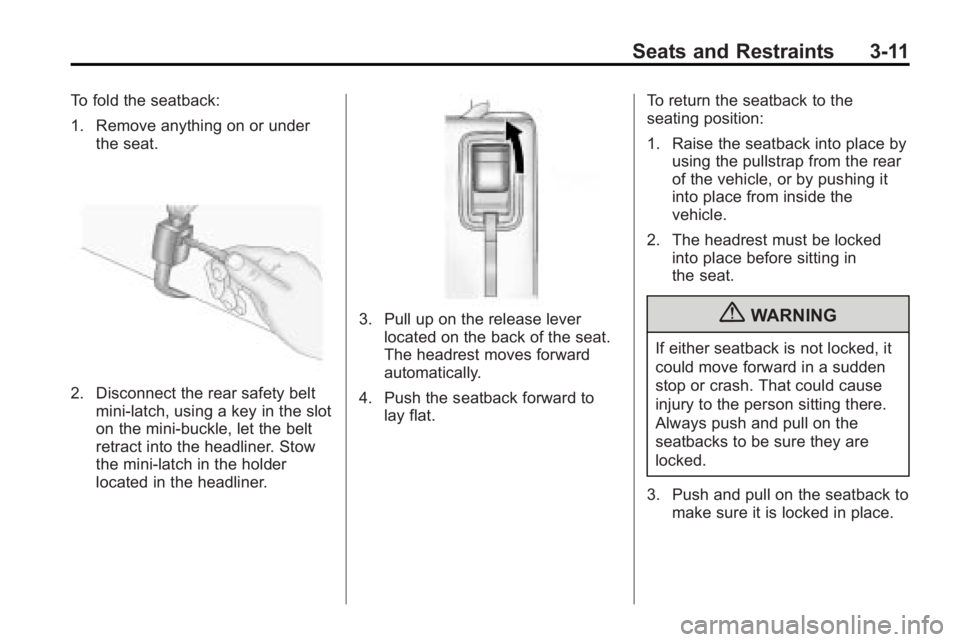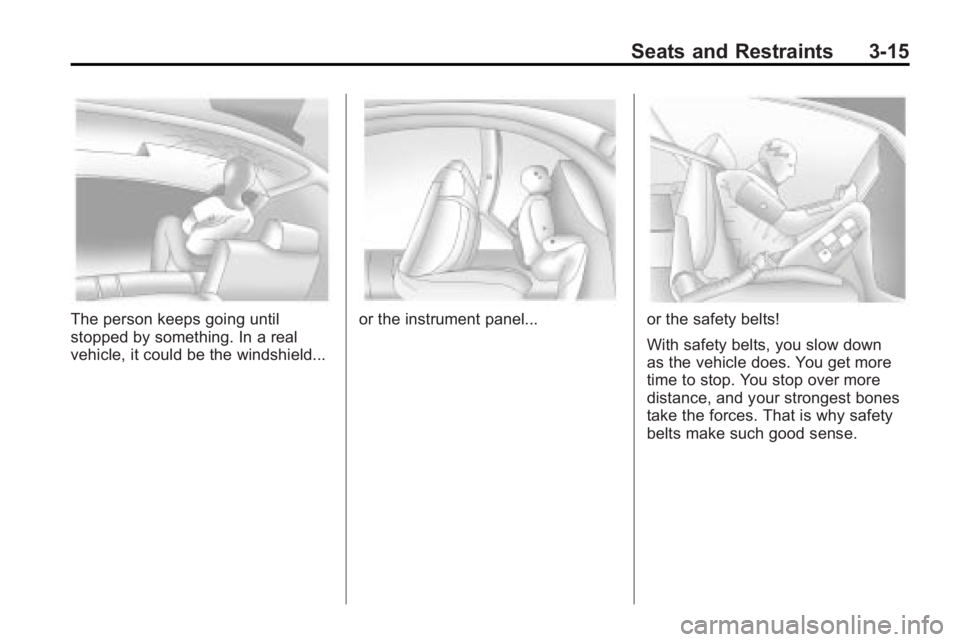BUICK ENCLAVE 2010 Repair Manual
Manufacturer: BUICK, Model Year: 2010, Model line: ENCLAVE, Model: BUICK ENCLAVE 2010Pages: 438, PDF Size: 2.47 MB
Page 61 of 438

Seats and Restraints 3-11
To fold the seatback:
1. Remove anything on or underthe seat.
2. Disconnect the rear safety beltmini-latch, using a key in the slot
on the mini-buckle, let the belt
retract into the headliner. Stow
the mini-latch in the holder
located in the headliner.
3. Pull up on the release leverlocated on the back of the seat.
The headrest moves forward
automatically.
4. Push the seatback forward to lay flat. To return the seatback to the
seating position:
1. Raise the seatback into place by
using the pullstrap from the rear
of the vehicle, or by pushing it
into place from inside the
vehicle.
2. The headrest must be locked into place before sitting in
the seat.{WARNING
If either seatback is not locked, it
could move forward in a sudden
stop or crash. That could cause
injury to the person sitting there.
Always push and pull on the
seatbacks to be sure they are
locked.
3. Push and pull on the seatback to make sure it is locked in place.
Page 62 of 438

3-12 Seats and Restraints
{WARNING
A safety belt that is improperly
routed, not properly attached,
or twisted will not provide the
protection needed in a crash.
The person wearing the belt could
be seriously injured. After raising
the rear seatback, always check
to be sure that the safety belts
are properly routed and attached,
and are not twisted.
4. Reconnect the center safety belt mini-latch to the mini-buckle.
Do not let it twist.
5. Pull on the safety belt to be sure the mini-latch is secure.
Removing the Third Row Seats
1. Remove the cargo management
system, if it is in the vehicle. See
Cargo Management System
on
page 4‑3.
2. Remove anything on or under the seat. Notice:
Folding a rear seat with
the safety belts still fastened may
cause damage to the seat or the
safety belts. Always unbuckle the
safety belts and return them to
their normal stowed position
before folding a rear seat.
3. Fold the seatback down. See “Folding the Seatback” earlier in
this section.
4. Remove the rear bolts located on the floor on each side of
the seat.
5. Remove the seat by tilting it slightly upward, and then pulling
it out of the rear of the vehicle in
one motion.
6. Replace the bolts in the floor holes for storage.
Installing the Third Row Seats
1. Before installing the seat theseatback must be folded
forward. See “Folding the
Seatback” earlier in this section. The seats must be placed in the
proper locations to attach
correctly. The wider seat must
be installed on the driver side
and the narrower seat on the
passenger side. Remove the
bolts from the holes in the floor
before installing the seats.
2. Place the seat on the vehicle floor so that the front seat hooks
are on the vehicle bars.
3. Reinstall the bolts, and torque to 55Y (41 lb ft). Pull up on the
seat to make sure it is locked in
place.
4. Raise the seatback to its upright position. Push and pull on the
seatback to make sure it is
locked into place.
5. Push the headrest up into position. Push and pull on the
headrest to make sure it is
locked into place.
6. Reconnect the center safety belt mini-latch to the mini-buckle.
Do not let it twist.
Page 63 of 438

Seats and Restraints 3-13
Safety Belts
This section of the manual
describes how to use safety belts
properly. It also describes some
things not to do with safety belts.
{WARNING
Do not let anyone ride where a
safety belt cannot be worn
properly. In a crash, if you or your
passenger(s) are not wearing
safety belts, the injuries can be
much worse. You can hit things
inside the vehicle harder or be
ejected from the vehicle. You and
your passenger(s) can be
seriously injured or killed. In the
same crash, you might not be,
if you are buckled up. Always
fasten your safety belt, and check
that your passenger(s) are
restrained properly too.
{WARNING
It is extremely dangerous to ride
in a cargo area, inside or outside
of a vehicle. In a collision, people
riding in these areas are more
likely to be seriously injured or
killed. Do not allow people to ride
in any area of your vehicle that is
not equipped with seats and
safety belts. Be sure everyone in
your vehicle is in a seat and using
a safety belt properly.
This vehicle has indicators as a
reminder to buckle the safety belts.
See Safety Belt Reminders
on
page 5‑16for additional
information. In most states and in all Canadian
provinces, the law requires wearing
safety belts. Here is why:
You never know if you will be in a
crash. If you do have a crash, you
do not know if it will be a
serious one.
A few crashes are mild, and some
crashes can be so serious that even
buckled up, a person would not
survive. But most crashes are in
between. In many of them, people
who buckle up can survive and
sometimes walk away. Without
safety belts they could have been
badly hurt or killed.
After more than 40 years of safety
belts in vehicles, the facts are clear.
In most crashes buckling up does
matter ... a lot!
Page 64 of 438

3-14 Seats and Restraints
Why Safety Belts Work
When you ride in or on anything,
you go as fast as it goes.
Take the simplest vehicle. Suppose
it is just a seat on wheels.
Put someone on it.Get it up to speed. Then stop the
vehicle. The rider does not stop.
Page 65 of 438

Seats and Restraints 3-15
The person keeps going until
stopped by something. In a real
vehicle, it could be the windshield...or the instrument panel...or the safety belts!
With safety belts, you slow down
as the vehicle does. You get more
time to stop. You stop over more
distance, and your strongest bones
take the forces. That is why safety
belts make such good sense.
Page 66 of 438

3-16 Seats and Restraints
Questions and Answers About
Safety Belts
Q: Will I be trapped in the vehicleafter a crash if I am wearing a
safety belt?
A: You could be—whether you are
wearing a safety belt or not. But
your chance of being conscious
during and after an accident, so
you canunbuckle and get out, is
much greater if you are belted.
And you can unbuckle a
safety belt, even if you are
upside down. Q: If my vehicle has airbags,
why should I have to wear
safety belts?
A: Airbags are supplemental
systems only; so they work with
safety belts —not instead of
them. Whether or not an airbag
is provided, all occupants still
have to buckle up to get the
most protection. That is true not
only in frontal collisions, but
especially in side and other
collisions. Q: If I am a good driver, and I
never drive far from home,
why should I wear safety
belts?
A: You may be an excellent driver,
but if you are in a crash —even
one that is not your fault —you
and your passenger(s) can be
hurt. Being a good driver does
not protect you from things
beyond your control, such as
bad drivers.
Most accidents occur within
40 km (25 miles) of home. And
the greatest number of serious
injuries and deaths occur at
speeds of less than
65 km/h (40 mph).
Safety belts are for everyone.
Page 67 of 438

Seats and Restraints 3-17
How to Wear Safety Belts
Properly
This section is only for people of
adult size.
Be aware that there are special
things to know about safety belts
and children. And there are different
rules for smaller children and
infants. If a child will be riding in the
vehicle, seeOlder Children
on
page 3‑44or Infants and Young
Childrenon page 3‑46. Follow
those rules for everyone's
protection.
It is very important for all occupants
to buckle up. Statistics show that
unbelted people are hurt more often
in crashes than those who are
wearing safety belts.
Occupants who are not buckled up
can be thrown out of the vehicle in
a crash. And they can strike others
in the vehicle who are wearing
safety belts. First, before you or your
passenger(s) wear a safety belt,
there is important information you
should know.
Sit up straight and always keep
your feet on the floor in front of you.
The lap part of the belt should be
worn low and snug on the hips, just
touching the thighs. In a crash, this
applies force to the strong pelvic
bones and you would be less
likely to slide under the lap belt.
If you slid under it, the belt would
apply force on your abdomen. This
could cause serious or even fatal
injuries. The shoulder belt should go
over the shoulder and across the
chest. These parts of the body are
best able to take belt restraining
forces.
The shoulder belt locks if there is a
sudden stop or crash.
Page 68 of 438

3-18 Seats and Restraints
Q: What is wrong with this?
A:The shoulder belt is too loose.
It will not give as much
protection this way.
{WARNING
You can be seriously hurt if your
shoulder belt is too loose. In a
crash, you would move forward
too much, which could increase
injury. The shoulder belt should fit
snugly against your body. Q: What is wrong with this?
A:
The lap belt is too loose. It will
not give nearly as much
protection this way.
Page 69 of 438

Seats and Restraints 3-19
{WARNING
You can be seriously hurt if your
lap belt is too loose. In a crash,
you could slide under the lap belt
and apply force on your
abdomen. This could cause
serious or even fatal injuries. The
lap belt should be worn low and
snug on the hips, just touching
the thighs.Q: What is wrong with this?
A:
The belt is buckled in the wrong
buckle.
{WARNING
You can be seriously injured if
your belt is buckled in the wrong
place like this. In a crash, the belt
would go up over your abdomen.
The belt forces would be there,
not on the pelvic bones. This
could cause serious internal
injuries. Always buckle your belt
into the buckle nearest you.
Page 70 of 438

3-20 Seats and Restraints
Q: What is wrong with this?
A:The belt is over an armrest.
{WARNING
You can be seriously injured if
your belt goes over an armrest
like this. The belt would be much
too high. In a crash, you can slide
under the belt. The belt force
would then be applied on the
abdomen, not on the pelvic
bones, and that could cause
serious or fatal injuries. Be sure
the belt goes under the armrests. Q: What is wrong with this?
A:
The shoulder belt is worn under
the arm. It should be worn over
the shoulder at all times.